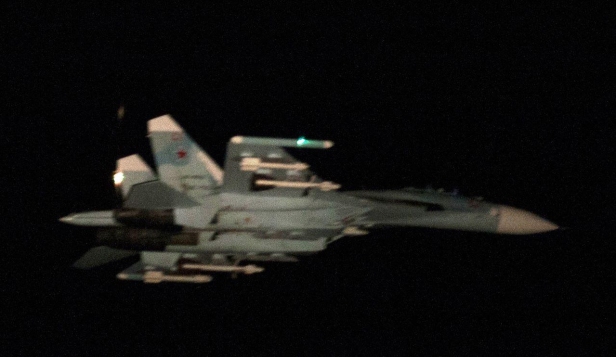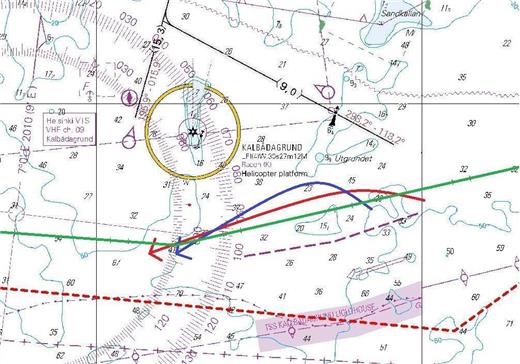It seems evident that 6 October was a day of heavy Russian military air traffic in the Gulf of Finland, reminiscent of certain episodes during the second half of 2014. Unfortunately, another episode also reminded of 2014, in that the Russians twice intruded on Finnish airspace. The first intruder was a single Su-27P, ‘red 42’ (RF-92414), which briefly entered Finnish airspace over the sea south of Porvoo 16:43 local time. It was intercepted by Finnish QRA, which duly photographed the armed Russian fighter.

The Russians had time to deny this incident, before the next intrusion took place at exactly the same place a few hours later. Another Su-27P in the ‘Red 4x’ sequence flew the same route inside Finnish airspace, and was documented by Finnish QRA at 21:33.

Both aircraft carry a mix of short-range highly manoeuvrable R-73 IR-missiles, mid-range R-27T IR-missiles, as well as long-range R-27ER semi-active radar-seeking missiles. This varied load-out is nothing new, and e.g. on this photo taken by US fighters during the Cold War the same missiles (though in older versions) are found on the same stations.

In theory the mix gives the Su-27 and unprecedented ability to target different airborne targets near and far, though in reality the different versions of the R-27 are starting to show their age. The lack of an active radar seeker on the R-27ER is also a significant handicap.
As noted, both intrusions took place at the same location, outside of Porvoo. A map released by the Finnish Border Guards leave little doubt that the intrusions were intentional, as both fighters flew the same track with a few hours in between. Both fighters entered Finnish airspace flying straight towards Kallbådagrund lighthouse (and in the general direction of Helsinki), and then turning parallel to the border just inside of it, before dashing out at the same location.

Notable is that while earlier intrusions have often been by cargo planes, and have often been blamed on the weather (in the cases where the Russians have conceded that they indeed have intruded on Finnish airspace), the weather during 6 October was good, with no reason to deviate. It is extremely rare that Russia have made these ‘visits’ with fighters, and the use of armed fighters to send a message like this is a step up in rhetoric.
An interesting question is related to the general state of readiness for the Finnish fighters. The closest permanent QRA is stationed at Kuopio-Rissala airbase in the central parts of Finland, from where the flight time would seem prohibitively long (especially as there has been no reports of supersonic flights by the Finnish Air Force).

The air force naturally refuses to give any details regarding the alert level and where the fighters that intercepted the Russian air traffic were based. During 2014 it was acknowledged that the air force temporarily based Hornets on civilian air fields in the southern parts of the country, including Helsinki-Vantaa international airport, to reduce intercept times. Finnish MoD Jussi Niinistö praised the reaction times of the Hornets, and noted that in addition to the two intruding Su-27P’s an unspecified number (‘several’) of identification flights were made. He also noted that this took place on the same day that Finland signed the bilateral defence cooperation deal with the US, and that the Russian behavior did not affect this in any way. It seems likely that the Finnish Air Force had some kind of prior knowledge, or that they were able to change their stance and react very quickly to the sudden increase in air traffic.
The Finnish authorities have asked the Russian ambassador to explain the intrusions.
In yet another twist, Estonian airspace was intruded upon a couple of hours after the second Porvoo-incident.
The QRA duty for the Estonian airspace is currently handled by a detachment of German Eurofighters, which, like their Finnish colleagues, had flown a number of identification flights during 6 October. If the intruder was photographed is not yet known. The Eurofighters currently operating out of Ämari air base are five aircraft from TaktLwG 74, homebased in Neuburg. The raw performance of the Eurofighter when it comes to climb rate and acceleration makes it right at home when it comes to these kinds of intercepts, and according to open sources the German fighters reached 848 knots (~1.3 Mach) during their missions, the highest speed noted in any intercept over the Gulf of Finland during 6 October.

Another part of the puzzle came on 7 October, when Estonian sources claimed that the ro-ro vessel Ambal then in transit was carrying Iskander missiles to Kaliningrad. The vessel is operated by Anrusstrans, which sports a small and varied fleet of cargo vessels and tugs. The vessel arrived in Baltiysk on the evening of 7 October. Crucially, she had been transiting the Gulf of Finland during 6 October, leading some to speculate that the Russian fighters had been escorting her. It is possible that the air and sea traffic was part of an exercise aimed at practising how to transfer reinforcements to Kaliningrad, an operation which would require air superiority over the Gulf of Finland and eastern parts of the Baltic Sea during the transit, though a traditional escort mission where fighters would follow a lumbering merchantman at (relatively) close range seems unlikely. It is also unclear if the Iskanders are the only units moved to the exclave during the last days, or if other units have been transferred as well.
https://twitter.com/alperboler/status/783540653695303680
Of further interest is the fact that on 5 October it was reported that two Buyan-M class corvettes that had transited the Bosphorus seemingly heading towards Syria, instead could be heading for the Baltic Sea. The introduction of these highly capable corvettes armed with Kalibr cruise missiles in the Baltic Sea would add significant fire power to the Russian Baltic Fleet.


Not too late for Scandinavia and Finland to declare their neutrality. Small birds.
New warplanes will come too late.
Declaring neutrality… Yeah, that worked out well for Belgium, Norway, Denmark, and some others last time around. Sad fact is that small countries don’t get a say in whether we want in on the latest crisis or not.
Kiitos. Seems that “guests” were fully equipped for the party (missiles). Is it known if armament observed before, during similar incidents after end of Cold war?
As far as I know Russian planes always fly fully armed with air-to-air missiles, NATO QRF-flights have at least short-range missiles at the wingtips and Swedish Air force normally only have the internal cannon.
Reblogged this on vara bungas.